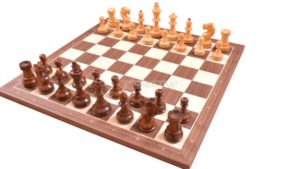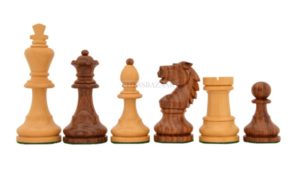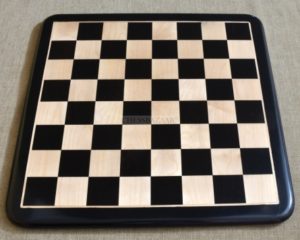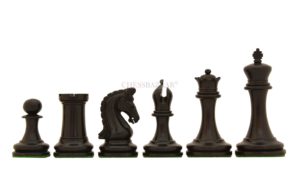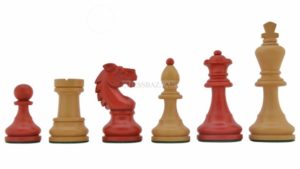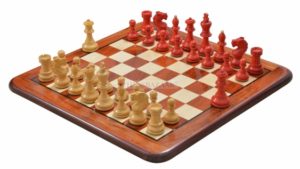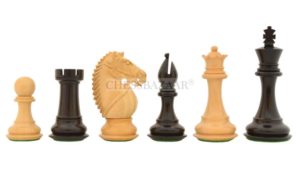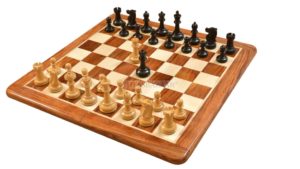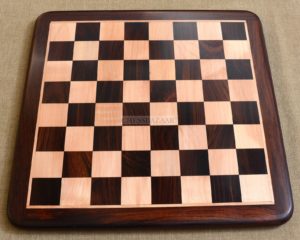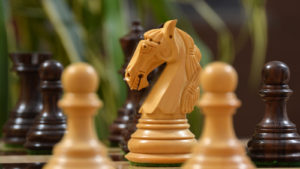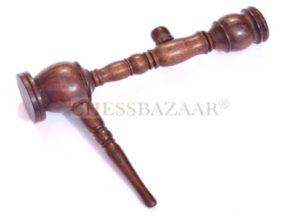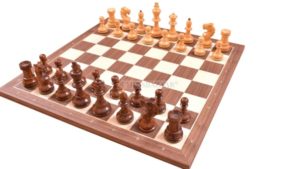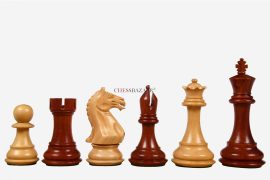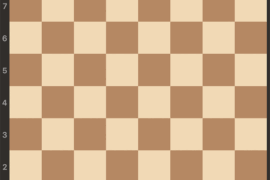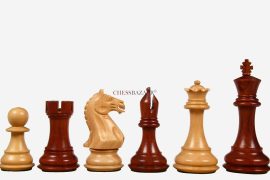Before 1989, the majority of the chess sets were made of Ivory.
A little bit about Ivory…
Ivory is a hard, white material from the tusks (traditionally elephants’) which is prized for its beauty, durability, and suitability for carving.
The population of African elephants declined from 1.35 million to 750,000. Looking at the humongous decline, the CITES (the Convention on International Trade in Endangered Species of Wild Fauna and Flora, also known as the Washington Convention) took a land sliding decision to ban international trade in African elephant ivory.
With heavy restrictions imposed on the use of Ivory, Craftsmen bear the toll, as the business was too big to be closed, the businesses decided to move from Ivory to Wood. Hence use of wood in hand-crafted products became the new norm. Like every other hand-crafted item chessmen were starting to be manufactured in wood. Use of wood increased three folds.
Now Unlike Ivory, Woods for chess boards are much more diverse than those for pieces. There are so many types of wood used for chess boards and sets that we won’t be able to list every single one here.
Now you must be wondering does the variety of wood used to make Chess pieces really matter.
Yes, it does. It depends on the finish, durability and flexibility feature of the particular wood.
Types of Wood:
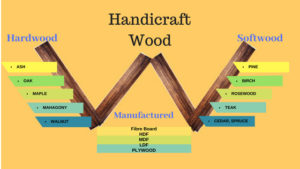 1. Sheesham Wood
1. Sheesham Wood 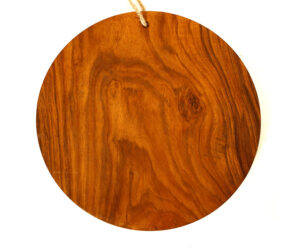
Common Names: Sissoo, Sheesham
Scientific Name: Dalbergia sissoo
Distribution: Primarily northern India, Nepal, and Pakistan, as well as Western Asia; also grown on plantations
Heartwood ranges from golden brown to a darker reddish brown.
Sheesham has good decay resistance and is rated as durable to very durable.
Sheesham wood, aka Indian Rosewood, is produced from a deciduous tree which is native to the Middle East. This type of wood neither warps nor splits. Sheesham’s texture has natural grain and marking with chestnut color.
Due to high water percentage, it has a higher flexibility; it’s also very cost-effective which makes it a favourite of chess set makers. Sheesham and Rosewood are very popular among the craftsmen because there are fewer chances of cracking and breakage than ebony and sandalwood. Sheesham wood is strong and beautiful for woodworking.
Mostly it’s distinguished for its wood grains and its double colour tone of light and dark yellow/brown. Another reason why it is popular among craftsmen is that it’s cheap and easily available. Did you know: It is capable of withstanding average annual rainfall of up to 2,100 millimetres and droughts of 2-4 months.
Related: Why do you play chess? By Conrad Conero
Some of the Sheehsam products available at chessbazaar:
a) Combo of Vintage 1950’s Circa Bohemia Chess Set in Sheesham & Box Wood & Walnut Maple Wooden Chess Board with Notation – 3.89″ King
2. Ebony Wood
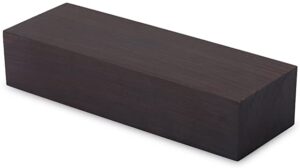
Common names: Ceylon Ebony, East Indian Ebony
Scientific Name: Diospyros ebenum
Distribution: Southeast Asia
Ebony is a jet black, sometimes with grey or dark brown streaks, the very best quality ebony looks like black plastic. Common uses involve Inlay, carving, musical instrument parts (piano keys, bridges, nuts, etc.), and turned objects.
Ebony is a luxurious wood, often called as the black wood. The natural state is dark brown but a chemical process can make it jet black.
Did you know: Ebony is used by Gibson Guitars for the fingerboards of some fine and classy guitars. Chess makers revere this wood for making luxurious chess sets.
More to Read: Why I collect chess sets, by John Lawson
Some products in Ebony at chessbazaar:
3. Boxwood

Common names: Boxwood, Common Box, European Box
Scientific Name: Buxus sempervirens
Distribution: Europe, northwest Africa, and southwest Asia
In color Boxwood tends to be a light cream to yellow, which tends to darken slightly with prolonged exposure to light. It is a light coloured wood that is used to make chess pieces and squares on chess boards. It is seldom used to make whole chessboards however Boxwood tends to be somewhat difficult to work in flat dimensions, though it is superbly suited for turning.
Commonly used for carving and turning, and the tree’s minute size halts it to smaller projects. Most common uses are chess pieces, musical instruments (flutes, woodwinds, etc.), rulers, , turned objects, and other specially made small items. It is a dense wood that is robust and ages nicely.
Honest chess set traders refer to this as ebonized boxwood, less honest ones will sell them as ebony pieces.
Some products in Boxwood at chessbazaar:
a) Special Edition Reproduced Vintage 1950’s Circa Bohemia Staunton Series German Chess Set in Stained Crimson Boxwood – 3.89″ King
4. Ebonized(Dyed) Boxwood
In simple words, Ebonised Boxwood is a stained version of Boxwood. It is commonly used to make chess pieces, the black side obviously; a very convincing attempt at producing an Ebony effect.
It’s cheaper than Ebony and is perfect for black chess pieces.
Regular boxwood is light in color and usually used for the white pieces. It’s ebonized for use as black pieces.
Some products in Boxwood at chessbazaar:
a) The Bridle Series Chess Pieces in Ebonized Boxwood & Natural Boxwood – 4.0″ King
b) Combo of 1972 Reproduced Fischer-Spassky Staunton Pattern Chess Set V2.0 in Ebonized Boxwood & Natural Boxwood – 3.75″ King
5. Indian Rosewood
Common names: East Indian Rosewood, Indian Rosewood, sonokeling
Scientific Name: Dalbergia latifolia
Distribution: India, Sri Lanka, and Indonesia
East Indian Rosewood has been used for acoustic guitars since the mid-1960s as a substitute for the now-endangered Brazilian Rosewood.
Rosewood like ebony is also considered as a luxury wood. Different variants of this wood comes from different parts it harvested from. It has a reddish tinge, this wood is dense yet not too hard, which makes it perfect for beautiful fingerboards on the guitars.
It is also used in the production of medium to high-end chess pieces, boards & folding sets.
Did you know: Rosewood was used by Fender guitars for their fingerboards from about 1959 onwards and rosewood was always considered a cheaper alternative to Ebony.
More to Read: Types of Chess Games
Some products in Boxwood at chessbazaar:
a) Wooden Chess Board Dark Brown Rose Wood 21″ – 55 mm
b) The New Columbian Staunton Series Chess Pieces in Rose Wood & Boxwood – 3.8″ King
c) Collectable Smoking pipe Rose Wood briar pipe Hookah 5-in-1.
6) Bud Rosewood aka Padauk Wood
Simply put, Bud Rosewood is wood that has been sourced from the base of the Rosewood tree. Quality-wise it leaves behind the normal Rosewood. Bud-Rosewood is used to make high-quality, high-end chess pieces and sets.
Some products in Boxwood at chessbazaar:
a) The Admiral Series II Staunton Chess Pieces in Bud Rosewood & Box Wood – 4.5″ King
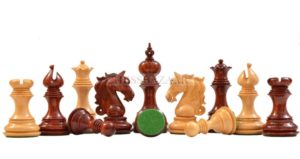
b) Combo of Apache Series Luxury Chess Pieces in Bud Rose / Box Wood with Bud Rosewood Chessboard – 4.5″ King
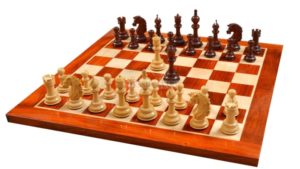
7) Rubber wood
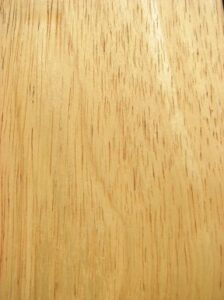
Common Name(s): Rubberwood, Plantation Hardwood, Para Rubbertree
Scientific Name: Hevea brasiliensis
Distribution: Basically from Brazil, but broadly cultivated in tropical regions, especially in Asia.
Rubber wood is naturally a light blonde to medium tan colour, sometimes with medium brown streaks, a wood used extensively in China for the production of wooden toys and games. Rubberwood is perishable, and has very little resistance to decay.
Ease of use with both hand and machine tools. Rubberwood tends to warp and twist in drying.
Related: What Are Triple Weighted/ Double/Non-Weighted Chess Pieces?
8) Maple Wood
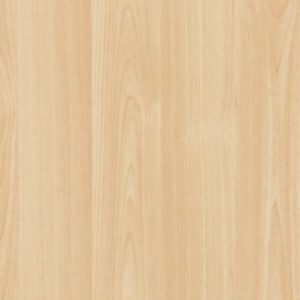
Scientific Name: Acer
Distribution: There are approximately 128 species, most are native to Asia, with a presence also in Europe, northern Africa, and North America.
Maple is a fairly dense and heavy wood. Used to produced musical instruments & chess pieces & sets.
Types: Hard Maple & Soft Maple
Hard Maple: refers to one specific type of maple species i.e. Acer saccharum. It is also known as rock maple or sugar maple, (this is the same tree which is tapped to get maple syrup).
Soft Maple: refer to any specific species of maple, but rather, it’s a broad term which includes various species of maple. The term “soft maple” is just used to disassociate these species from hard maple.
Some products in Maple wood at chessbazaar:
a) Walnut Maple Wooden Chessboard Matte Finish 15″ – 45 mm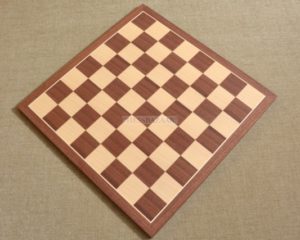
b) Combo of Vintage 1950’s Circa Bohemia Chess Set in Sheesham & Box Wood & Walnut Maple Wooden Chess Board with Notation – 3.89″ King
9) Pine Wood

Scientific name: Pinus
Distribution: Much of North America, China, South-East Asia, Russia and Europe
Pine wood is widely used in high-value carpentry items such as furniture, window frames, panelling, floors, and roofing, and the resin of some species is an important source of turpentine.
Pines are naturally found almost exclusively in the Northern Hemisphere. They are and have one of the largest distributions of any conifer family.
In regard to chess sets Try to avoid this wood unless you are looking for a very light weight and budget chess set.
Conclusion: According to Botanical Gardens Conservation International (BGCI) there are 60,065 species of trees around the world. BGCI compiled the tree list by using data gathered from its network of 500 member organisations.
Link to research: https://bbc.in/2p1GOZ6
As there are many more types of wood available in different parts of the world with various features, for chess making above described woods are most commonly used.
A manufacturer takes into consideration various factors before choosing the wood like availability, type of wood, Hardness and softness of wood , cost factors etc.
Read More: Skills to Master Through Chess

